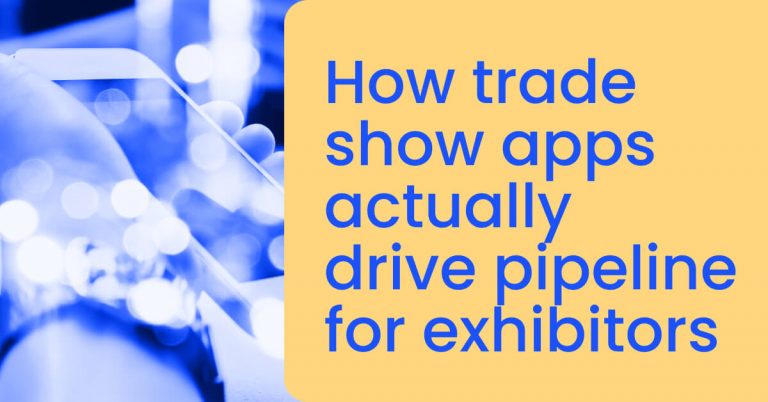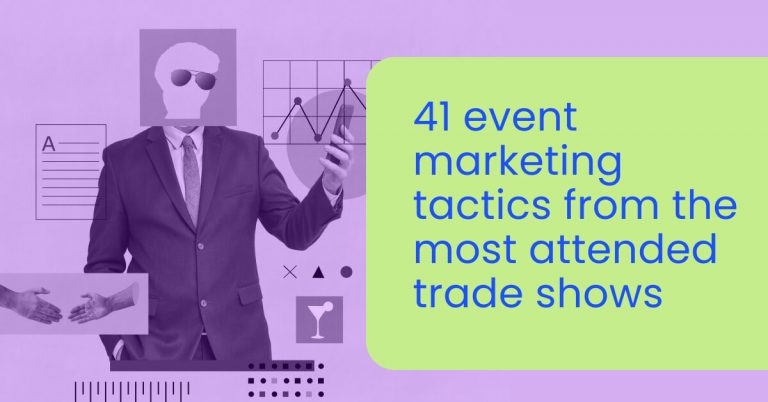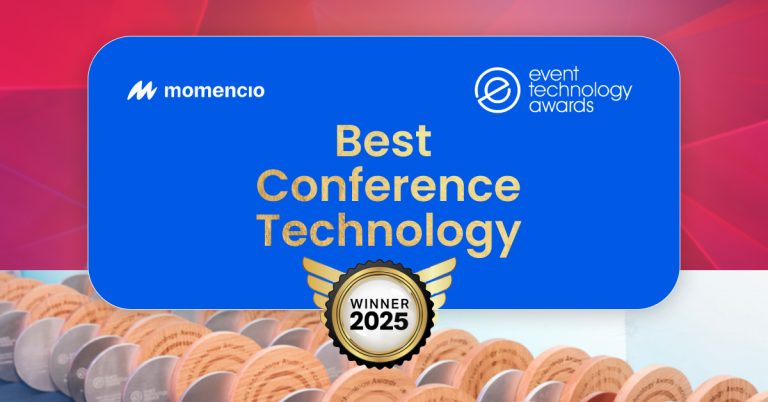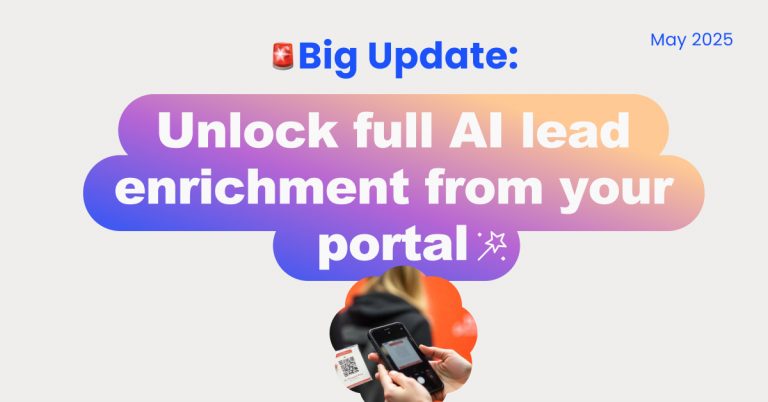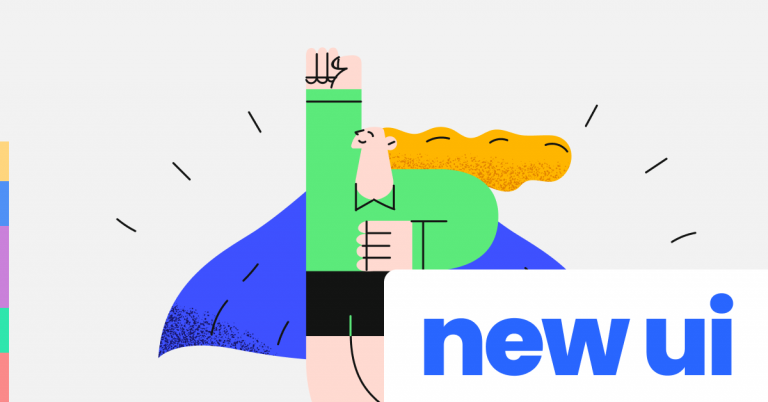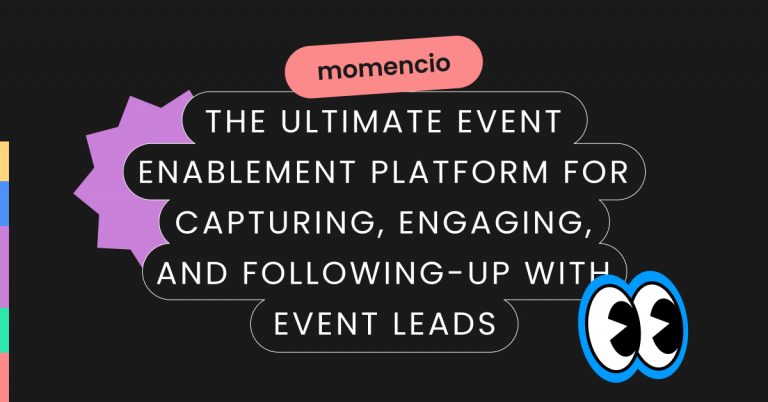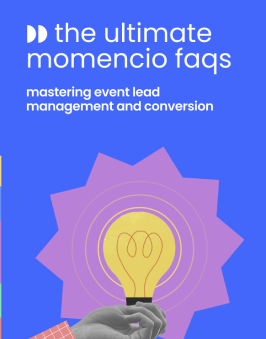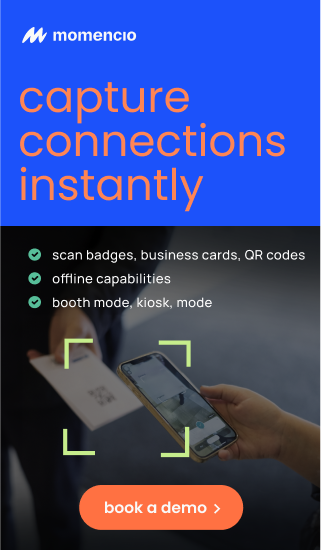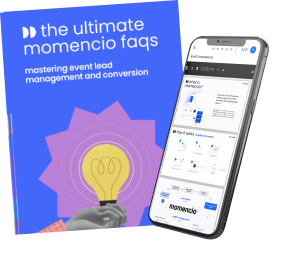Your sales team just returned from a major industry trade show. Three days of early mornings, back-to-back booth conversations, and 247 scanned badges later, everyone’s exhausted but optimistic. Your VP of Marketing proudly reports the numbers at Monday’s leadership meeting: “We captured 247 leads—our best show yet!”
But here’s what nobody mentions: by the end of Q1, 198 of those leads will have vanished into the void of your CRM, never receiving a single meaningful follow-up.
You’ve just watched $270,000 in potential pipeline evaporate.
The $5.4 billion problem hiding in plain sight
If this scenario sounds familiar, you’re not alone. Research reveals that 80% of trade show leads are never followed up on—a staggering failure rate that costs the U.S. B2B industry approximately $5.4 billion annually in wasted trade show investments.
But here’s where it gets worse: while 80% of companies let their leads go cold, the remaining 20% who follow up quickly are winning at an extraordinary rate. Studies show that 35-50% of sales go to the vendor that responds first, creating a massive competitive advantage for companies that crack the follow-up problem.
The math is brutal. The average mid-market B2B company spends $15,000 per trade show (booth space, travel, staff time, materials). With 80% of leads dying in the CRM, that’s a $12,000 loss per event. Multiply that across the 42 trade shows the average B2B tech company attends annually, and you’re looking at a half-million-dollar annual hemorrhage.
For VPs of Sales managing lean teams and demanding revenue targets, this isn’t just a marketing problem—it’s a fundamental breakdown in your revenue engine.
Why smart sales teams let trade show leads die
The traditional explanation for the 80% follow-up failure rate is simple: “Sales is too busy.” But after analyzing hundreds of trade show post-mortems, the real problem runs deeper.
The lead equality trap
Most companies treat every badge scan equally. Your CRM now contains 247 contacts with identical “Trade Show Lead” tags, zero context about conversation quality, and no indication of buying intent. Your sales reps, already managing 150 active opportunities, look at this undifferentiated list and make a rational decision: they focus on deals that are already warm.
According to research, only 5-15% of trade show leads are actually ready to talk to sales. Yet without real-time qualification data, your team has no way to identify which 12-37 leads in that batch of 247 deserve immediate attention. So they either blast everyone with generic follow-ups (which converts poorly) or follow up with no one (which converts at zero).
The context decay curve
Even when sales teams intend to follow up, delays are deadly. One study tracking 2,200 companies found that sales reps who attempted contact within one hour were 7 times more likely to reach a decision-maker compared to those who waited just 60 minutes longer.
Yet the typical trade show follow-up process looks like this:
- Days 1-3: Leads sit in badge scanner
- Day 4: Marketing exports and begins “cleaning” the data
- Days 5-7: Leads imported to CRM
- Day 8+: Sales finally begins outreach
By day 8, your leads’ memory of your booth conversation has faded. They’ve already taken calls from three competitors who followed up on day 2. The window has closed.
The invisible handoff
In 42% of companies, marketing assumes sales will handle trade show follow-up. In those same companies, sales assumes marketing will nurture leads first. This classic miscommunication means nobody follows up at all—and neither team realizes it until someone runs a pipeline attribution report months later.
The 24-48 hour window that determines everything
While 80% of companies struggle with week-long delays, leading sales organizations have identified a critical window: 24-48 hours post-event.
Research tracking buyer behavior shows that 50% of buyers choose the vendor that follows up first with relevant information. But “first” doesn’t mean “send a generic ‘nice to meet you’ email.” It means re-engaging with personalized context while the trade show energy is still fresh.
This creates a compounding advantage. Teams that respond within 24 hours report:
- 60% higher conversion rates compared to teams that delay
- 3X improvement in lead-to-opportunity conversion when context from booth conversations is preserved
- 35-50% win rate advantage from first-mover positioning
The reason is psychological: immediately after a trade show, your prospect is in “evaluation mode.” They’re comparing solutions, booking demos, and making decisions. Wait until next week, and they’ve returned to “execution mode”—focused on existing projects, not new vendors.
Five diagnostic questions every VP should ask today
Not sure if your trade show process has this $270K leak? Ask your team these five questions:
- “How long does it take for a trade show lead to receive their first personalized follow-up?”
If the answer is “5-7 days” or “it depends,” you have a speed problem. Best-in-class teams measure this in hours, not days.
- “What percentage of our trade show leads are qualified as hot/warm/cold at the event?”
If the answer is “we qualify them later” or “we don’t really categorize them,” you have a prioritization problem. Without onsite qualification, your sales team treats gold and gravel identically.
- “Can you tell me what conversation happened at booth #14 with Sarah Chen from TechCorp?”
If your rep needs to search through notes, check business cards, or can’t remember at all, you have a context preservation problem. Real-time capture of conversation details is the difference between relevant follow-up and spam.
- “Who owns the trade show lead follow-up process—marketing or sales?”
If there’s any hesitation or disagreement, you have an ownership problem. The 24-48 hour window requires crystal-clear responsibility.
- “What percentage of our trade show leads ultimately convert to opportunities?”
If you don’t track this metric or it’s below 15%, you’re likely part of the 80% leaving money on the table.
How top-performing teams solve the follow-up crisis
The companies winning 35-50% of deals through first-responder advantage aren’t just moving faster—they’ve fundamentally redesigned their trade show process around three principles:
Real-time lead intelligence over batch processing
Instead of collecting business cards for later data entry, winning teams capture detailed qualification data during booth conversations. Modern event intelligence platforms allow reps to scan badges, log conversation notes, record buying signals, and score leads—all in real-time—so the lead data reaches the CRM enriched with context, not just contact details.
A leading B2B tech company reported that after implementing real-time lead capture with conversation logging, their lead-to-opportunity conversion rate jumped from 8% to 24%. The difference? Their follow-up emails referenced specific pain points discussed at the booth, making outreach feel like a continuation of the conversation rather than cold prospecting.
The first 48 hours protocol
High-performing teams don’t wait until after the show ends to begin follow-up. They implement a 48-hour rapid response protocol:
- Hour 0-6 (while still at the event): Hot leads receive immediate personalized email with calendar link for demo
- Hour 6-24: Warm leads receive personalized email referencing booth conversation
- Hour 24-48: All other qualified leads receive segmented follow-up based on interest level
- Week 2+: Automated nurture sequences begin for non-responsive leads
This tiered approach ensures high-intent prospects never go cold while preventing follow-up fatigue on cooler leads.
Eliminating the marketing-sales handoff
Leading sales organizations have eliminated the traditional handoff entirely. Instead, trade show leads flow directly to sales reps’ workflow systems with all context preserved. Marketing provides content and sequences, but sales owns the relationship from the first booth conversation through closed deal.
Companies using this model report 78% higher conversion rates compared to those with traditional handoff processes. Why? Because there’s no gap where leads fall through the cracks, and no context gets lost in translation.
The real cost of inaction
At this point, some VPs push back: “Our sales team is already stretched thin. How can we add more follow-up work?”
This framing reveals the fundamental misunderstanding. The 80% follow-up failure isn’t a capacity problem—it’s a systems problem.
Consider the economics: Your average trade show lead costs $600 to acquire (show costs divided by leads generated). If 80% of those leads never receive follow-up, you’re essentially writing a $120,000 check (200 leads × $600) and lighting it on fire.
Meanwhile, your sales team continues cold prospecting—which generates leads at $800+ per qualified opportunity. You’re spending more to generate worse leads while ignoring the pre-qualified prospects you already invested in.
The alternative? Fix the system. Companies that implement automated lead intelligence, real-time qualification, and structured follow-up protocols report that each sales rep can effectively manage 2-3X more trade show leads without increasing workload—because they’re focusing energy on the 15% that matter, not the 85% that don’t.
Moving from $270k leak to revenue engine
The path forward isn’t complicated, but it does require confronting an uncomfortable truth: the way your company has always done trade show follow-up isn’t working.
Start by measuring your current baseline. Calculate your actual trade show investment per lead, track your follow-up speed, and honestly assess your conversion rates. For most mid-market B2B sales teams, this analysis reveals that 60-80% of trade show ROI is being left on the table.
Then ask yourself the diagnostic questions above. If you can’t answer them with confidence, or if the answers reveal gaps in speed, context, or ownership, you know where to focus.
The companies winning the first-responder advantage aren’t smarter or better resourced—they’ve simply stopped accepting that “80% of leads die in the CRM” as an inevitable cost of doing business.
Because in an environment where half of all deals go to the fastest responder, the $270K question isn’t whether you can afford to fix your trade show follow-up process.
It’s whether you can afford not to.






